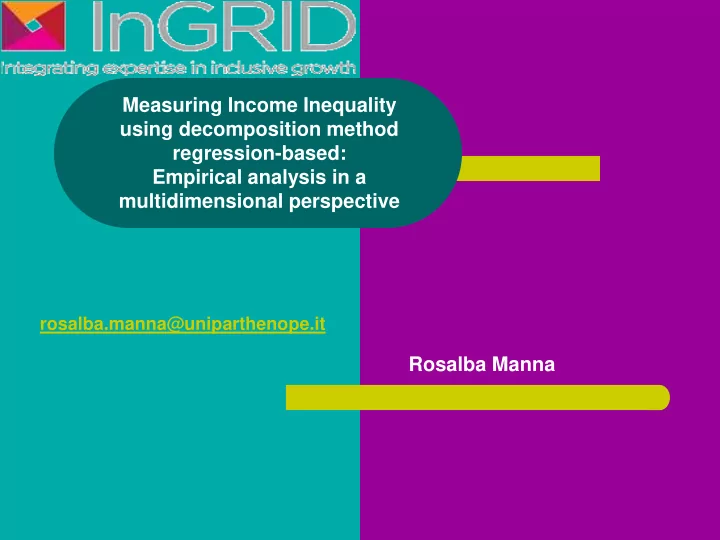

Measuring Income Inequality using decomposition method regression-based: Empirical analysis in a multidimensional perspective rosalba.manna@uniparthenope.it Rosalba Manna
Aim To measure the relative contributions of individual as well as household factors to the explanation of the inequality in individual disposable incomes in Italy A regression-based decomposition technique was implemented, following the Shapley approach The analysis exploited the potential of panel data, with reference to the pooling of observations on a cross-section of individuals over several time periods 2
Inequality Decomposition Traditional Decomposition Regression-based Decomposition Population Income Source Subgroups Shapley-Value Fields Approach 3
Shapley-Value Approach Traditional decomposition Regression-based decompositon Income Source Population Subgroups Shapley-Value Fields Approach 4
Income generating model First step: – specification and estimation of an income generating function – the choice of the functional form is dictated by the standard Mincer model – the log of income is regressed on some explanatory variables accounting for individual (human capital) and household (physical capital) characteristics. 5
Model Selection Second step: A model for longitudinal data with random effects is selected – = = β + + 1 , 2 ,..., t T log y x c u it it i it = 1 , 2 ,..., i N This model allows to capture the heterogeneity between individuals in – several time periods and between the same individual observed in several time periods 6
Model Assumptions The individual effects of this model are strictly uncorrelated with the regressors This hypotesis allows to include time-invariant regressors This is not possible when we estimate the fixed effects model 7
Survey of Bank of Italy on Household Income and Wealth The data come from the Survey of Household Income and Wealth (SHIW) from which we selected the information on the income earners who have been successfully interviewed every two years from 2004 to 2014 (balanced panel) Such an information includes a large number of individuals N (N=1712) observed over a short time period T (T=6 years covering on a whole time span of 10 years). 8
Variables in the model Variables Variable name Description Log of Income Y Net individual disposable income (euro) Gender GENDER =1 for male =0 for female Education EDUCATION Years of completed study Age AGE age Age squared AGE2 Age squared Work status WORK =1 for employes =0 for self employed Geographical Area AREA =1 North and Center =0 South and Islands Household wealth WEALTH Household real and financial wealth (thousands of euro) 9
Model Estimation 10
Interpretation output The signs of the coefficients are in line with the theory Significant income gaps are found by gender, level of education, work status and geographical area The concavity of income-age profile is confirmed Larger income flows are associated with larger stocks of wealth 11
Inequality decomposition through Shapley approach The Gini index I(Y) calculated on predicted income values is expressed as the sum of the contributory factors = ∑ k ( ) ( ) Φ I Y X , I i = i 1 12
Shapley Value Approach ( ) Φ X i , I X The contribution of each i is estimated through a sequence of regression models starting from the satured model and then proceeding by eliminating each regressor in succession. Since the contribution of any factor depends on the order in which the factor appears in the elimination sequence, the overall marginal contribution is given by the average calculated over all the possible elimination sequences 13
Gini Decomposition Variables Absolute Percentage Contribution Contribution Gender 10.60 30.89 Education 11.80 32.29 Age 3.50 10.20 Work 3.19 9.30 Area 2.82 8.22 Wealth 0.53 1.54 Total Explained Inequality 31.72 92.45 Unexplained Inequality 2.59 7.55 Observed Inequality 34.31 100.00 14
Results Education plays a dominant role in the explanation of observed inequality Gender has the second largest contribution Less importance is accorded to household wealth Age, work status and area of residence affect the income differentials only in a residual way 15
Thanks for your attention Rosalba Manna rosalba_manna@yahoo.it
Recommend
More recommend